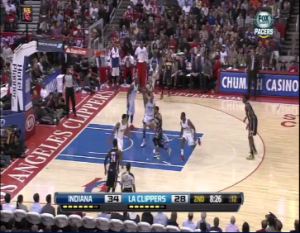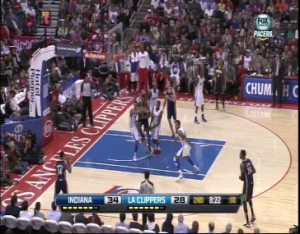While the Miami Heat were busy reaffirming their position as sole and rightful kings of the Eastern Conference, the growing cast of aspiring Western Conference contenders continued its battle for supremacy. The Denver Nuggets (17-3 since the all-star break 8.9 net rating) and Memphis Grizzlies (16-6 5.2 net rating) established themselves as threats to the West’s upper echelon, a level of public regard from which the Los Angeles Clippers have fallen since the beginning of the season. The Clippers responded to a slow start to the season with a winning streak at which only the Heat can scoff. Spanning the month of December, the Clippers won 17 games in a row, and outscored opponents by 16.1 points per 100 possessions. This streak, spurred by Chris Paul and the frantic “bench mob,” established the Clippers as contenders, a height from which they have slowly fallen. Since the streak ended, the Clippers are outscoring their opponents by only 2.6 points per 100 possessions (nba.com), which would rank 10th in the league over the full season, and have won 24 of 43 games. In a recent ESPN NBA 5 on 5, 3 of the 5 writers polled classified the Clippers as “pretenders,” while a fourth was, “on the fence.” Though this is not necessarily representative of public opinion (and I wouldn’t put much value in Chris Palmer’s analysis), the perception of the Clippers as contenders has clearly faded.
The Clippers feature Chris Paul, the best point guard in basketball, who is widely considered the 3rd best player in the league (tied for second in win shares per 48 minutes per basketball reference), Blake Griffin, one of the better power forwards (4th in ws/48 among forwards and centers), and a generally strong bench unit including dynamic scorer and 6th man of the year candidate Jamal Crawford, Matt Barnes, a no longer fat Lamar Odom, and Eric Bledsoe. So what prevents the Clippers from playing at a higher level? Coaching, or at least offensive and defensive strategy and execution, appear to play a large part in the Clippers shortcomings.
Though critics often focus on the Clippers drought-prone offense, the underachieving defense costs them just as often. The Clippers have allowed 101 points per 100 possessions on the season, and have surrendered 103.8 since the end of their streak. Though the Clippers suffer defensively from a lack of big man defenders off the bench, many of their problems may be schematic. Hickory High’s expected points per shot metric calculates the expected points per shot allowed by a team by finding the league points per shot average from various zones on the floor and comparing the percentage of opponent attempts from each zone allowed by a team. Defenses, at least the good ones, are designed to allow as few attempts from 3, especially in the corners, and from the restricted areas as possible. These two areas have the highest Expected Points per Shot of any zone, and the leagues best defenses, focused on denying opportunities from theses areas (the league-best Pacers allow the fewest shots in the restricted area and 2nd fewest corner 3s), consistently have the lowest Expected Points per Shot Allowed. Through January 7th, the Clippers did a poor job denying opponents attempts from high efficiency areas, allowing a 20th ranked 1.05 XPPS. Though personnel limits defensive performance, the ability of a defense to force an offense into taking low efficiency shots is often dictated by both approach and execution. Hickory-High’s XPPPS data was last updated January 7th, but the focus is on the Clipper’s defensive strategy, and as their defensive rating has actually worsened since that date, the data is useful in reflecting the presence of flaws in the Clippers approach. Per mysynergysports.com, the Clippers allow 1 point per play (different from points per possession in that per possession includes offensive rebounds as a single scoring opportunity, meaning that an missed shot followed by a put back dunk would produce 2 points per possession and 1 per play) to opposing spot up attempts, ranking 20th in the league. Open spot opportunities are typically the result of poor rotations, which are often a product of a compromising strategy.
To begin this play, Eric Bledsoe takes a bad angle trying to go over a high screen for DJ Augustine and is trapped behind the play, allowing Augustine to get into the lane.
Ryan Hollins steps up to defend Augustine, who kicks it out to Ian Mahinmi a couple feet inside the free throw line. Because Bledsoe and Hollins switched in the pick and roll coverage, Hollins is left guarding DJ Augustine, who leaks to the corner, while Matt Barnes guards Paul George on the left wing. Bledsoe then makes a mistake indicative of a poorly coached team. He rushes to close out on the open Mahinmi, who shoots only 33.6% on mid range jumpers (nba.com). Even if Mahinmi were a much better shooter, Bledsoe should likely have allowed the mid-range jumper. Had Bledsoe instead trailed his original man, Augustine, through the play, Hollins would be free to close out on Mahinmi. Instead, Mahinmi penetrates off Bledsoe’s overzealous close out. Leaving Hollins to protect the paint and guard Augustine in the corner.
Hollins stays in the paint to contest Mahinmi’s drive, and is unable to recover to contest Augustine’s 3. However, even at this point Augustine should not have been open. Compounding Bledsoe’s blown pick and roll coverage, Matt Barnes, the lone left side perimeter defender, now responsible for both George and Augustine, decided to help down on Mahinimi’s drive. Barnes should have allowed the helping Hollins and Bledsoe to contest the offensively challenged Mahinmi’s drive and stayed in position to contest the corner three, allowing Bledsoe to recover to George above the break if Augustine decided to pass. Instead, the Clippers allow a wide-open corner three, the best shot in basketball.
The Clippers have been plagued by ill-advised defensive rotations all season, and allow the 13th most 3-point attempts per game (per hoopdata hooray for non-pace adjusted stats! I couldn’t find the per possession number ranking), 86.3% of which are assisted, the 5th highest rate in the league, confirming the inability to deny opponents open spot-up 3s. The efficient, well-coached offenses the Clippers will face in the playoffs will be prepared to take advantage of the Clippers rotation issues. The Clippers also allow 0.84 points per play against isolation attempts, per mysynergysports.com. Though isolation is typically perceived as a one on one battle, the presence of back line defenders is key against NBA caliber offensive players. The Clippers rank 22nd overall in defending isolation, displaying how their big men are often out of position to contest or deny isolation attempts. Though he has made significant improvements as a defender this year, Blake Griffin has a habit of staying tight to his man defensively, often turning his head from the play, and not stepping off and in into the key to deny penetration.
Offensively, the Clippers issues may be overrated. Per basketball-reference, the Clippers score 109.9 points per 100 possessions, the 5th highest rate in the league, and, per mysynergysports.com, rank 3rd in both pick and roll ball handler and roll man points per play and 7th in spot up, which account for a combined 35.7% of their offense. As transition opportunities decline in the playoffs, the Clippers will likely focus their half court execution on the very efficient Chris Paul – Blake Griffin pick and roll. The Clippers offense is prone to notable dry spells, during which they often rely on Jamal Crawford isolations to create scoring. The glaring lack of movement in many Clipper sets does not reflect well on coach Del Negro, however the Clippers are generally able to score efficiently regardless. The Clippers offense excels when Griffin and Paul share the court, scoring 110.7 points per 100 possessions (nba.com). This season Chris Paul has only played 33.3 minutes per game, but in the playoffs will likely average over 40. As Griffin and Paul play more, the Clippers offense will likely experience fewer offensive dry-spells. Though they have slipped in the public’s eye, the Clippers players still believe that they are championship contenders, and if they can tighten some defensive issues, they may prove themselves to be correct.




